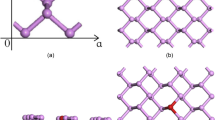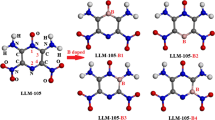Abstract
Context
A first-principles approach based on density functional theory was used to explore the effect of bending deformation on the electrical structure of molybdenum ditelluride doped with nonmetallic atoms X (X = B, C, N, and O). The study included alternate doping of nonmetallic atoms, as well as a comparison of the effects of intrinsic bending deformation and nonmetallic doping deformation. The results demonstrate that boron atom doping raises the Fermi energy level. Examining the energy band structure indicates that the intrinsic molybdenum ditelluride is a direct band gap semiconductor, which is transformed from a direct band gap to an indirect band gap after doping. We selected boron-doped systems for bending deformation and compared them with the intrinsic systems. With increasing deformation, all systems start to shift from semiconductor to metal. When the deformation reaches 8°, the energy levels fill and the electron energy increases. The intrinsically bent systems transition from direct band gap to indirect band gap and eventually to metal. The indirect band gap semiconductor-to-metal transition process occurs after the bending deformation of the boron-doped atoms. The analytical results show that the absorption and reflection peaks of the molybdenum ditelluride system are blue-shifted after the bending deformation of the boron-doped atoms.
Methods
Under fundamental principles, this research depends on the density functional theory framework (DFT) using the CASTEP module in the Materials-Studio software. The plane-wave pseudopotential approach with modified gradient approximation and the Perdew-Burke-Ernzerhof (PBE) generalized function is used for structure optimization and total energy calculations of the X-doped (X = B, C, N, O) MoTe2 system at different shape variables. Geometry optimization of the 27-atom superlattice MoTe2 was carried out, followed by alternative doping of tellurium atoms in the molybdenum ditelluride with B, C, N, and O. In this paper, the intrinsic bending deformation and B-doping of molybdenum ditelluride were selected for deformation analysis. Intrinsic bending deformations and boron-doped molybdenum ditelluride with bending angles ranging from 2° to 8° were employed for deformation investigation. In Fig. 1, pink is used to represent doped B atoms, orange is used to describe Te atoms, and green is used to represent Mo atoms. For the degree of deformation of molybdenum ditelluride, in this paper, it is expressed by the bending angle, i.e., the angle of the plane of molybdenum ditelluride after bending and deformation of a single layer of molybdenum ditelluride concerning the angle of the plane folded for the deformed plane. How to do it: For ease of presentation, the atomic chains are set to different colors. The purple part on both sides of the figure is bent and deformed, 3–5 atoms are fixed appropriately, and the middle part is deformed. On this basis, the bending deformation of intrinsically doped and boron-doped MoTe2 is comparatively analyzed. The effect of boron-doped atoms on the structure of MoTe2 is systematically investigated to study its structural stability and electronic structure.

a1 and a2 The main and side views of intrinsic MoTe2; b1 and (b2) the main and side views of MoTe2 doped with boron atoms bent by 8°










Similar content being viewed by others
Data availability
The datasets supporting the conclusions of this article are included within the article, and further information about the data and materials could be made available to the interested party under a motivated request addressed to the corresponding author.
References
Lindahl N, Midtvedt D, Svensson J, Lindvall N, Isacsson A, Campbell EEB (2012) Determination of the bending rigidity of graphene via electrostatic actuation of buckled membranes. Nano Lett 12(7):3526–3531
Ghosh S, Calizo I, Teweldebrhan D (2008) Extremely high thermal conductivity of graphene: prospects for thermal management applications in nanoelectronic circuits. Appl Phys Lett 92:151911–151913
Geim AK, Novoselov KST (2007) The rise of graphene. Nat Mater 6(3):183–191
Park KH, Lee D, Kim J (2014) Defect-free, size-tunable graphene for high-performance lithium ion battery. Nano Lett 14(8):4306–4313
Takada K, Sakurai H, Takayama-Muromachi E (2003) Superconductivity in two-dimensional CoO2 layers. Nature 422(6927):53–55
Puthussery J, Seefeld S, Berry N (2011) Colloidal iron pyrite (FeS2) nanocrystal inks for thin-film photovoltaics. J Am Chem Soc 133(4):716–719
Lee C, Li Q, Kalb W (2010) Frictional characteristics of atomically thin sheets. Science 328:76–80
Tan CL, Cao XH, Wu XJ, He QY, Yang J, Zhang X, Chen JZ, Zhao W, Han SK, Nam GH, Sindoro M, Zhang H (2017) Recent advances in ultrathin two dimensional nanomaterials. Chem Rev 117:6225–6331
Zhang WX, Huang ZS, Zhang WL, Li YR (2014) Two-dimensional semiconductors with possible high room temperature mobility. Nano Res 7:1731–1737
Huo NJ, Yang SX, Wei ZM, Li SS, Xia JB, Li JB (2014) “Photoresponsive and gas sensing field-effect transistors based on multilayer WS2 nanoflakes. Sci Rep 4:5209
Chhowalla M, Shin HS, Eda G, Li LJ, Loh KP, Zhang H (2013) “The chemistry of two-dimensional layered transition metal dichalcogenide. Nanosheets Nat Chem 5:263–275
Ataca C, Sahin H, Ciraci S (2012) Stable, Single-layer MX2 transition-metal oxides and dichalcogenides in a honeycomb-like structure. J Phys Chem C 116:8983–8999
Pan H, Zhang YW (2012) Edge-dependent structural, electronic and magnetic properties of MoS2 nanoribbons. J Mater Chem 22:7280–7290
Yin ZY, Li H, Li H, Jiang L, Shi YM, Sun YH, Lu G, Zhang Q, Chen XD, Zhang H (2012) Single-layer MoS2 phototransistors. ACS Nano 6:74–80
Li Y, Zhang XX, Chen DC, Xiao S, Tang J (2018) Adsorption behavior of COF2 and CF4 gas on the MoS2 monolayer doped with Ni: a first-principles study. Appl Surf Sci 443:274–279
Zhang X, Tan QH, Wu JB (2016) Review on the Raman spectroscopy of different types of layered materials. Nanoscale 8:6435–6450
Cha J, Sung D, Min KA, Hong S (2018) Van der Waals density functional theory study of molecular adsorbates on MoX2 (X = S, Se or Te). J Korean Phys Soc 73:100–104
Feng ZH, Xie Y, Chen JC, Yu YY, Zheng SJ, Zhang R, Li QN, Chen XJ, Sun CL, Zhang H, Pang W, Liu J, Zhang DH (2017) Highly sensitive MoTe2 chemical sensor with fast recovery rate through gate biasing. Mater 4(2):025018
Xu X, Li X, Liu K (2018) Thermodynamics and kinetics synergetic phase-engineering of chemical vapor deposition grown single crystal MoTe2Nanosheets. Cryst Growth Des 18(5):2844–2850
Behzad S, Chegel R (2024) Tailoring thermoelectric properties through carbon doping and magnetic field variation: a comparative study in 2D h-BN and h-SiC. Chin J Phys 87:398–414
Chegel R (2023) Remarkable thermopower property enhancement in two-dimensional SiC via B and N doping and magnetic field. J Alloys Compd 967:171682
Chegel R (2023) Magneto-electronic and thermopower properties of B, N and Si doped monolayer graphene. Diamond Relat Mater 137:110154
Ma Y, Dai Y, Guo M (2011) Electronic and magnetic properties of perfect, vacancy-doped, and nonmetal adsorbed MoSe2, MoTe2 and WS2 monolayers. Phys Chem Chem Phys 13(34):15546–15553
Wang M-M, Zhang J-M, Ali A, Wei X-M, Huang Y-H (2021) The structure, electronic, magnetic and optical properties of the Co-X (X = B, C, N, O or F) codoped single-layer WS2. Physica E 15(134):114917
Solomenko A, Balabai R, Radchenko T, Tatarenko V (2022) Functionalization of quasi-two-dimensional materials: chemical and strain-induced modifications, Prog. Phys. Met 23:147–238
Dai Z, Liu L, Zhang Z (2019) Strain engineering of 2D materials: issues and opportunities at the interface. Adv Mater 31:1805417
Cooper RC, Lee C, Marianetti CA (2013) Nonlinear elastic behavior of two-dimensional molybdenum disulfide. Phys Rev B 87(3):035423
Neto AHC, Guinea F, Peres NMR (2009) The electronic properties of graphene. Rev Mod Phys 81(1):109–162
Novoselov KS (2011) Nobel lecture: graphene: materials in the flatland. Rev Mod Phys 83(3):837–849
Butler SZ, Hollen SM, Cao L (2013) Progress, challenges, and opportunities in two-dimensional materials beyond graphene. ACS Nano 7(4):2898–2926
Xu M, Liang T, Shi M (2013) Graphene-like two-dimensional materials. Chem Rev 113(5):3766–3798
Wu G, Lou H, Liu K (2020) The study of bending properties of monolayer MoS2 in non-collinear electrodes using first principles theory. Phys Chem Chem Phys 22(38):21888–21892
Mu G-Y, Liu G-L, Zhang G-Y (2020) Bending deformation regulates the electronic and optical properties of black phosphorene. Int J Mod Phys B 34(20):2050191
Clark SJ, Segall MD, Pickard CJ, Hasnip PJ, Probert MIJ, Refson K, Payne MC (2005) First principles methods using CASTEP. Z Kristall 220:567–570
Perdew JP, Wang Y (1992) Accurate and simple analytic representation of the electron-gas correlation energy. Phys Rev B 45(23):13244–13249
Hybertsen MS, Louie SG (1986) Electron correlation in semiconductors and insulators: band gaps and quasiparticle energies. Phys Rev B 34:5390–5413
Yang K, Cui Z, Li E et al (2023) Modulation of the magnetic, electronic, and optical behaviors of WS2 after metals adsorption: a first-principles study. Chem Phys 571:111903
Kan M, Nam HG, Lee YH, Sun Q (2015) Phase stability and Raman vibration of the molybdenum ditelluride (MoTe2) monolayer. Phys Chem Chem Phys 17:14866–14871
Feng Z, Xie Y, Chen J, Yu Y, Zheng S, Zhang R, Li Q, Chen X, Sun C, Zhang H, Pang W, Liu J, Zhang D (2017) Highly sensitive MoTe2 chemical sensor with fast recovery rate through gate biasing. 2d Mater 4(2):025018
Guo H, Yang T, Yamamoto M, Zhou L, Ishikawa R, Ueno K, Tsukagoshi K, Zhang Z, Dresselhaus MS, Saito R (2015) Double resonance Raman modes in monolayer and few layer MoTe2. Phys Rev B 91(20):205415
Nakaharai S, Yamamoto M, Ueno K, Lin Y, Li S, Tsukagoshi K (2015) Electrostatically reversible polarity of ambipolar α-MoTe2 transistors. ACS Nano 9(6):5976–5983
Szary M, Florjan DM, Babelek JA (2022) Sheet doping for improved sensitivity of HCl on MoTe2. Surf Sci 716:121964
Dai Y, Liu G, He J, Ni J, Zhang G (2023) Torsional deformation modulation of the electronic structure and optical properties of molybdenum ditelluride systems doped with halogen atoms X (X = F, Cl, Br, I): a first-principles study. J Mol Model 29(11):356
Rui-hua MA, Shan-shan LIU, Xia XIN, Hui-ying ZHOU, Meng-qi REN, Dong-lan WU (2020) Study on the electric structure and optical electrical characteristic of MoTe2. J Jing gang shan Univ: Nat Sci Ed 41(1):10–15 ((in Chinese))
Funding
This work was supported by the Department of Science & Technology of Liaoning Province (grant number 2023-MSLH-266).
Author information
Authors and Affiliations
Contributions
L, as the corresponding teacher, made the main directions of the paper. D, as the first author, wrote the main manuscript text. H, Y, and Z checked the chart and conceived the direction of their papers. All authors read and approved the final manuscript.
Corresponding author
Ethics declarations
Ethical approval
This article does not contain any studies involving animals performed by any of the authors.
Consent to participate
Informed consent was obtained from all individual participants included in the study.
Consent for publication
All the authors mentioned in the manuscript have given consent for submission and subsequent publication of the manuscript.
Competing interests
The authors declare no competing interests.
Additional information
Publisher's Note
Springer Nature remains neutral with regard to jurisdictional claims in published maps and institutional affiliations.
Rights and permissions
Springer Nature or its licensor (e.g. a society or other partner) holds exclusive rights to this article under a publishing agreement with the author(s) or other rightsholder(s); author self-archiving of the accepted manuscript version of this article is solely governed by the terms of such publishing agreement and applicable law.
About this article
Cite this article
Dai, Y., Liu, G., He, J. et al. Bending deformation modulation of the optoelectronic properties of molybdenum ditelluride doped with nonmetallic atoms X (X = B, C, N, O): a first-principles study. J Mol Model 30, 94 (2024). https://doi.org/10.1007/s00894-024-05895-3
Received:
Accepted:
Published:
DOI: https://doi.org/10.1007/s00894-024-05895-3




